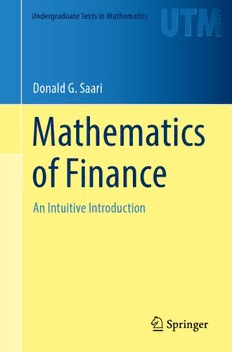Table Of ContentUndergraduate Texts in Mathematics
Donald G. Saari
Mathematics
of Finance
An Intuitive Introduction
Undergraduate Texts in Mathematics
Undergraduate Texts in Mathematics
SeriesEditors
SheldonAxler
SanFranciscoStateUniversity,SanFrancisco,CA,USA
KennethRibet
UniversityofCalifornia,Berkeley,CA,USA
AdvisoryBoard
ColinAdams,WilliamsCollege,Williamstown,MA,USA
DavidA.Cox,AmherstCollege,Amherst,MA,USA
L.CraigEvans,UniversityofCalifornia,Berkeley,CA,USA
PamelaGorkin,BucknellUniversity,Lewisburg,PA,USA
RogerE.Howe,YaleUniversity,NewHaven,CT,USA
MichaelE.Orrison,HarveyMuddCollege,Claremont,CA,USA
LisetteG.dePillis,HarveyMuddCollege,Claremont,CA,USA
JillPipher,BrownUniversity,Providence,RI,USA
FadilSantosa,UniversityofMinnesota,Minneapolis,MN,USA
Undergraduate Texts in Mathematics are generally aimed at third- and fourth-
year undergraduate mathematics students at North American universities. These
texts strive to provide students and teachers with new perspectives and novel
approaches.Thebooksincludemotivationthatguidesthereadertoanappreciation
ofinterrelationsamongdifferentaspectsofthesubject.Theyfeatureexamplesthat
illustratekeyconceptsaswellasexercisesthatstrengthenunderstanding.
Moreinformationaboutthisseriesathttp://www.springer.com/series/666
Donald G. Saari
Mathematics of Finance
An Intuitive Introduction
123
DonaldG.Saari
DepartmentsofEconomics
andMathematics
UniversityofCalifornia
Irvine,CA,USA
ISSN0172-6056 ISSN2197-5604 (electronic)
UndergraduateTextsinMathematics
ISBN978-3-030-25442-1 ISBN978-3-030-25443-8 (eBook)
https://doi.org/10.1007/978-3-030-25443-8
MathematicsSubjectClassification:91Gxx,91G20,91F99
©SpringerNatureSwitzerlandAG2019
Thisworkissubjecttocopyright.AllrightsarereservedbythePublisher,whetherthewholeorpartof
thematerialisconcerned,specificallytherightsoftranslation,reprinting,reuseofillustrations,recitation,
broadcasting,reproductiononmicrofilmsorinanyotherphysicalway,andtransmissionorinformation
storageandretrieval,electronicadaptation,computersoftware,orbysimilarordissimilarmethodology
nowknownorhereafterdeveloped.
Theuseofgeneraldescriptivenames,registerednames,trademarks,servicemarks,etc.inthispublication
doesnotimply,evenintheabsenceofaspecificstatement,thatsuchnamesareexemptfromtherelevant
protectivelawsandregulationsandthereforefreeforgeneraluse.
Thepublisher,theauthors,andtheeditorsaresafetoassumethattheadviceandinformationinthisbook
arebelievedtobetrueandaccurateatthedateofpublication.Neitherthepublishernortheauthorsor
theeditorsgiveawarranty,expressorimplied,withrespecttothematerialcontainedhereinorforany
errorsoromissionsthatmayhavebeenmade.Thepublisherremainsneutralwithregardtojurisdictional
claimsinpublishedmapsandinstitutionalaffiliations.
ThisSpringerimprintispublishedbytheregisteredcompanySpringerNatureSwitzerlandAG.
Theregisteredcompanyaddressis:Gewerbestrasse11,6330Cham,Switzerland
Formygoodfriend
ArthurPancoe
Atruefinancialwizard!
Note to Instructors
Thesenotesweremotivatedbyconversationswithgraduatingseniorsinmathemat-
ics and economics who were headed for the finance world. Finance? From where
didtheygettheirtraining?ItturnedoutatthattimeatNorthwesternUniversitythere
werenorelevantundergraduatecourses.Andso,afterdiscussionswithcolleagues
from the Departments of Finance and of Economics, I developed a course for the
MathematicsDepartment.
Based on the advantages gained by students who have taken this course,
includingjobopportunitiesandanewfocusoncoursematerial,Ibelievethatsuch
acourseshouldbeofferedinmostundergraduatemathprograms.Andso,thisbook
is designed to help the reader grasp the fundamentals. This is both for students
and for instructors who wish to teach the course but may be hesitant without a
previousbackground.Courseenrollmentshavebeenahealthymixturewhereabout
half are math majors and the other half are mathematically stronger students from
economicsandelsewhere(e.g.,engineering,graduatestudents,etc.).Aftermymove
tothesunnierclimesattheUniversityofCalifornia,Irvine,thenotesweremodified
tomeettherealitiesoflargerclasssizes.
Thecourseaddressesseveralneeds:
1. Capstone: Students learn a considerable amount of mathematics as undergrad-
uates, but many fail to see how it is connected, what to do with it, or how it is
relevant for their future. Even more, many either forgot fundamental concepts
or never moved beyond technical details to grasp the absorbing power of
mathematics.
Asanexample,itisnotunusualtofindstudentswhodismissTaylorseriesas
a side topic or as an illustration of infinite series. They most surely carried out
numerousexercisesyetfailedtorecallthat,forpracticalpurposes,thispowerful
toolrequiresonlyafinitenumberofterms.Then,manyfailtorememberhowto
createTaylorseriesforseveralvariables.Thematerialwastaught,butforsome
(notall),itwasforgotten.
So,ratherthanassumingstudentsrecallmaterialfromearliercourses(includ-
ing basic concepts from probability and statistics), the relevant concerns are
vii
viii NotetoInstructors
quickly reviewed with an emphasis on their power and utility. This is not a
course on these subjects, so an intuitive review, rather than a detailed, rigorous
exposition,ispresented.Anicefeatureofthisfinancetopicisthatitincorporates
so many mathematical concepts, which explain why the course has served as a
capstoneforstudentswithonlyapassingcuriosityaboutfinance.
2. Introduction: The main purpose is to introduce students to the fundamentals of
themathematicsoffinance.Mostarriveknowingnothingaboutthisarea,sothis
book starts with basics and quickly moves to more complicated material. The
choice of material is directed to provide a mathematical understanding of the
fundamentals with an emphasis on why certain equations and concepts are of
valueandwhattheyreallymean.
It is standard in some courses, for instance, to present the solution for the
Black–Scholes Equation without explaining from where terms come, why they
shouldbeexpected,andwhattheymean.Onewaytoclosethisgapistocarefully
solve the Black–Scholes Equation. But once the course’s popularity attracted
classesofaround200students,timelimitationsmadethisimpossible.
Fortunately,theBlack–Scholessolutioncanbeunderstoodwithoutsolvingthe
partialdifferentialequation;itsufficestoappreciatehowchangesofvariables(to
converttheBlack–ScholesEquationintotheheatequation)aremanifestedinthe
final solution. In this manner, students understand from where and why terms
ariseratherthanconfrontingaconfusingmemorylesson.Attentioncanthenbe
focussedonwhatallofthismeans.
3. Developing mathematical intuition: Students who have taken this course have
directlyenteredthefinanceworldormovedtograduateprogramstolearnmore.
This means that they must develop intuition for what is being presented, the
limitationsofvariousconclusions,1 andwhattopicsareopenforresearch.
Limitations are emphasized throughout the book starting with the intro-
duction. Students catch on: they begin to appreciate the importance of those
hypothesesthat,inthepast,theymighthaveignored.Betterstudentsrecognize
whereaddedresearchisrequired.
To help students develop an instinctive understanding of the material, the
approachofthisbookdiffersfromatraditionalcourse:newmaterialisintroduced
intermsofwhattheycanreadilygrasp.Thatis,topicsarelaunchedwithstories
or closely related themes.2 The definition and significance of arbitrage, for
instance, are introduced in the first chapter with a simple gambling example.
The limitations of the “Efficient Market Hypothesis” are compared with the
constraintsofaquadraticTaylorseriesrepresentationfory =cos(x).
1This is critical: After the 2008 crash, some government experts attended an NRC committee
meeting to explore what they missed. A couple were surprised to discover that key equations
fromthisareaarenotalwaysapplicable.Whenonewonderedhowtodiscoversuchinformation,I
volunteeredmybetterstudents.
2Thisappealtogeneralconceptsavoidsthecommonproblemwhereyoumustknowsomething
aboutfinancebeforeyoucanstudy(orteachacourse)inthisarea.
NotetoInstructors ix
Teaching always involves compromises between time and depth of coverage,
suchasinquarterlengthcourses.Myadviceistopacethecoursetoensurethatthe
messagesofChapters6,7,and8arecovered.Notdoingsowouldbeakintoreading
anAgathaChristiemysterynovelonlytodiscoverthatthelastchaptersaremissing.
Problems at the end of each chapter are roughly in the order of the chapter’s
presentation,whichmakesiteasierforassigninghomework.Comingupwithother
problems,bymimickingexamplesinthetext,iseasy.Mystudentsareresponsible
foralltheproblemsincoveredchapters,andmyspotquizzestypicallycomefrom
changingnumbersinassignedproblems.
Ideally,thecourseshouldemphasizehowthepowerofmathematicssignificantly
assists developing a sense, an intuition, about the market. When the material
becomesmathematicallymoretechnical,thereisadangerthatstudentswillfocuson
mathematicaldetailsattheexpenseofdevelopingintuitionaboutfinancialoptions.
Tocounterthis,“intuitionbreaks”areinsertedinvariouslocations.Manyserveas
reasonablehomeworkproblems.
Subjecttotimeconstraints,otherfeaturescanbeaddressed.Tosuggestopportu-
nitieswhenteachingacourseondynamics,itispossibletoappealtoNewton’slaw
orblocksslidingdowninclinedboards.Butfortheuninitiated,muchofeconomics
is a mysterious world; instinct, experience, and intuition should be provided. OK.
How?
Central to the material is the “buy low, sell high” phrase. A way to experience
this cliché (time permitting) is with an experiment where a portion of the class,
thesuppliers,producewidgets:infact,theybuythemfromanimaginary“Sue.”A
differentportionoftheclassarethebuyersorconsumers.Thevalueeachattaches
towidgetsisdeterminedasfollows:eachconsumercanpurchasewidgetsfromthe
suppliersandsellthemtome.
Reflecting different levels of manufacturing expertise, Sue offers different
studentsdifferentprices(asspecifiedonslipsofpaperthatthestudentsdrawfroma
bowl);theyhavenoideawhatpricestheothersuppliershave.Similarly,eachbuyer
drawsaslipfromabowlwhichstateswhatIwillpayforawidget;differentbuyers
havedifferentpricestoreflectthedifferentvaluesconsumersplaceonwidgets.
The market opens as soon as some student offers to buy, or sell, a widget at a
price they specify: if someone agrees, a sale is made, and the two are out of the
market.Eachpersonmarksontheslipthesalepricetodeterminepersonalprofits.
(The instructor’s role is to explain the process, ensure that the auction starts, and
maintainorder—whateverhappenswiththebiddinghappens.)Everythingcontinues
untilnomoresalescanbemade.Forinstance,Sue(i.e.,theslipsofpaperdrawnby
thestudentswhoaresuppliers)mayoffereachofsixstudentsapricefrom2,4,5,7,
9,and10;similarly,myoffersmaycomefrom3,5,6,6,8,and9.(Efficientgroup
sizesrangefrom25to30each;theyneednotbethesamesize.)Norealmoneyis
involved,butstudents,evenobservers,quicklybecomecaptivated.
Thisgameiscarriedoutseveraltimes(thereisalearningprocess;inlaterrounds,
studentsbecomemorestrategicandsophisticated)whereeachroundusesdifferent
prices.(So,ifastudentwitharawdealendsupinasubsequentround,sheorhemay
drawabetterchoice.)Themessageiswhenthesupplyanddemandcurvesfromeach
x NotetoInstructors
experiment are plotted on the board, the intersection is close to the price obtained
throughthegames:notonlydoesthisexerciseprovidevalidityforthesupplyversus
demandstory(forparticularsettings),butthebiddingprocessdemonstrateshowthe
“wisdomofthecrowd”influencesthesearchforanequilibriumprice.
Thiscourseisenjoyabletoteach!OfhelpforreadersaremyYouTubelectures
foundunder“Math176,MathematicsofFinance,”whichcovermostofthematerial
in this book. As for required background, students who have finished the calculus
sequence(severalvariables)andanintroductorycourseinprobabilityandstatistics
havebeensuccessful.
Finally, my thanks to Dan Jessie for corrections and suggested changes in the
notesafterhetaughtthiscourseseveraltimes.SantiagoGuisasolamodifiedportions
ofthesenotestoteachgiftedhighschoolstudentsinasummercamp.Mythanksto
AnneliDuffinandKatriSiebergfortheirassistanceduringthedevelopmentofthis
material.Thankstothefivereviewersfortheirusefulcomments.And,inparticular,
mythankstothemanystudentsfortheirfeedback!

